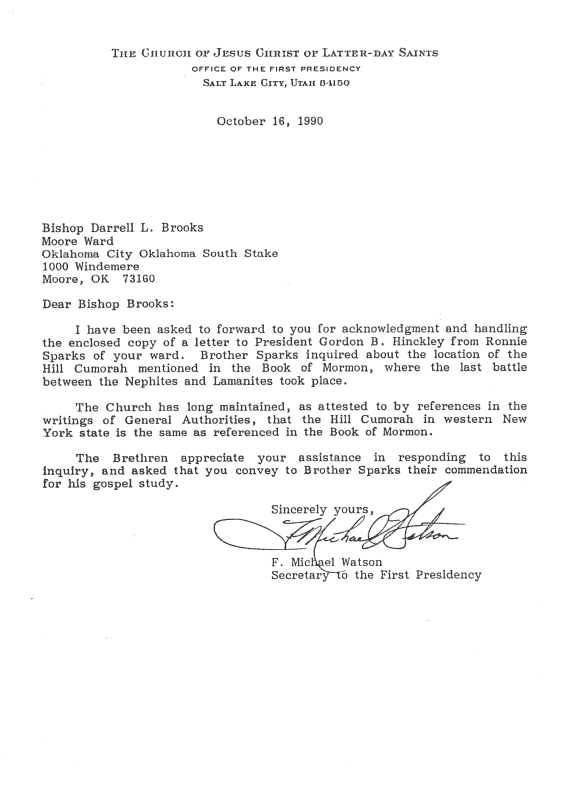Posted: Tue Mar 27, 2007 8:08 am
Fortigurn,
As to the DVD issue, it is not meant to be the subject of this discussion. It covers a vast number of issues that we cannot begin to discuss here. You have your opinion, and as usual you do not think the scholarship is any good. I on the other hand, have a differing opinion.
As for the Zelph issue, neither Gman nor Fortigurn have grasped what I have been trying to say.
Now, you can still choose to completely deny the facts, and pretend that the LDS church just made all that up to cover it's butt. Go ahead, it would be characteristic. However, it is the truth and it can be proven, but only to those who have the humility to see.
What is in dispute, is whether or not Joseph Smith left any record of the event himself. He did not. All we have are the memories of other men. That isn't really that big of a deal, except for the fact that Gman has repeatedly denied that fact.
I will give you the benefit of the doubt and assume you did not understand my position from the first. There should be no excuse now. I have been crystal clear. We have no record written by Joseph Smith that makes any reference to Zelph.
You need to admit that before we can move on. I will not discuss church history with someone who cannot admit to their mistakes.
Sargon
As to the DVD issue, it is not meant to be the subject of this discussion. It covers a vast number of issues that we cannot begin to discuss here. You have your opinion, and as usual you do not think the scholarship is any good. I on the other hand, have a differing opinion.
As for the Zelph issue, neither Gman nor Fortigurn have grasped what I have been trying to say.
You just are not getting it. Noone lied. Nobody at all has lied. They are all telling the truth. The event did happen, and many people witnessed it. There are enough reports of the event to prove that Joseph was involved, and that he said certain things about the bones uncovered. That is not in dispute.It cannot be avoided that at least one of them lied (Godfrey), or at worst three of them lied (Howe, Hancock, and Richards). But the real question is why any of them would lie.
Godfrey told the truth, and Willard Richards told the the truth. There was no forgery. It wasn't a secret, it wasn't a fake account that was trying to fool anyone. It was simply a style of writing history. It was understood that Joseph Smith did not actually write it. Willard Richards was an honest man just doing his job. They didn't have the literary standards that we have today, and so they did not include the fact that it was not actually written by Joseph Smith as we would today, a fact which has confused many critics of the LDS church, including Gman.But if Godfrey told the truth, then Willard Richards also lied, and this means that the 'Manuscript History of the Church' contains known forgeries.
Now, you can still choose to completely deny the facts, and pretend that the LDS church just made all that up to cover it's butt. Go ahead, it would be characteristic. However, it is the truth and it can be proven, but only to those who have the humility to see.
What is in dispute, is whether or not Joseph Smith left any record of the event himself. He did not. All we have are the memories of other men. That isn't really that big of a deal, except for the fact that Gman has repeatedly denied that fact.
Ok Gman, then find for me Joseph Smith's personal version of the Zelph event. The one you have provided is not it. It was written by Willard Richards, compiling all known versions of the story from different men.Sargon... You are wrong once again... Smith was there and wrote what he saw...
This is not the issue I am discussing. We are not interested just yet in the particulars of the event, we are not interested in debating whether or not the event happened. It did. We are interested in discovering whether or not Joseph Smith ever personally recorded anything about it as you have repeatedly claimed.Smith believed he and his men were standing on the plains and mounds of the Nephites, that they had picked up the skulls and bones of the Nephites, and that these things were evidences for the BoM.
I will give you the benefit of the doubt and assume you did not understand my position from the first. There should be no excuse now. I have been crystal clear. We have no record written by Joseph Smith that makes any reference to Zelph.
You need to admit that before we can move on. I will not discuss church history with someone who cannot admit to their mistakes.
Sargon
